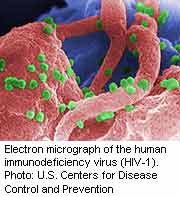
TUESDAY, March 1 (HealthDay News) — Experts are reacting with cautious optimism to the announcement Monday that researchers reconfigured immune cells so that they became resistant to HIV in six patients infected with the virus.
But they say the jury is out on whether the technique might ever spell an end to AIDS.
The goal is ultimately a cure or what’s called a “functional cure” — having the body permanently keep HIV at bay — but “we’re not there yet,” stressed Dr. Michael Kolber, professor of medicine and director of the Comprehensive AIDS Program at the University of Miami Miller School of Medicine.
The trial, reported Feb. 28 at a meeting of HIV specialists in Boston, “was a proof-of-principle that they could go in and do this. They demonstrated that the [genetically engineered] cells stayed in the patients, but the patients were not cured,” said Kolber, who was not involved in the new research.
Another expert agreed that the treatment’s true potential remains uncertain.
“If successful, this probably could have wide application, but going from six patients to an entire epidemic is a ways to go,” said Dr. Michael Horberg, director of HIV/AIDS at Kaiser Permanente Health Plan and vice chair of the HIV Medicine Association. “With other successes we’ve already had, that makes it more promising and people are starting to have a greater vision as to what’s possible.”
However, as Kolber pointed out, this trial was what’s known as a phase I trial, which means it was primarily looking at safety, not effectiveness, although investigators do often report on initial effectiveness results at this stage.
The idea came from an isolated case that first made headlines in 2009, involving the so-called “Berlin patient.” This man, an American AIDS patient living in Germany, was apparently cured after receiving blood cells from a donor who happened to have a rare, natural immunity to HIV.
“Most of us consider [the Berlin patient] functionally cured, after three-and-a-half years. They can’t find any virus,” Kolber said.
To determine whether this feat could be safely replicated in other patients, a group of researchers at California-based biotech company Sangamo BioSciences used genetic engineering to create HIV-resistant versions of CD4+ T-cells, the immune system cells that are the prime target of HIV. They did so by first removing some of these cells from six HIV-infected male patients.
The T-cells were then modified using a special gene-editing technique, and billions of the newly tweaked genes were then infused back into the HIV-positive men.
The modified cells lack a key protein receptor — also known as a “docking station” — called CCR5, through which HIV invades the T-cells that are major players in the human immune system. A very rare handful of people are naturally missing both copies of the CCR5 gene and have appeared to be completely resistant to HIV.
On Monday, the team announced that, three months later, the new HIV-resistant cells were flourishing within the patients — meaning that the men’s bodies were now making some of their own HIV-resistant cells.
“The procedure is safe (so far) and feasible, in that all patients can be treated (i.e. no manufacturing failures), and thus the phase I protocol has met its objectives and can be deemed ‘successful,'” said lead researcher Dr. Carl June, director of translational research at the Abramson Family Cancer Research Institute at the University of Pennsylvania School of Medicine.
“This is the first example of genetic editing to introduce a disease-resistance gene in patients: thus we have a new tool that will permit us to ask if we can eventually replicate the ‘Berlin’ patient with the patient’s own cells, and not require bone marrow transplant from an unrelated donor,” June explained. “A series of clinical trials can now be asked if we can increase the levels of HIV-resistant cells in patients (in this trial about 6 percent of CD4 cells on average) to approach 100 percent.”
Only those trials will get scientists closer to knowing whether the therapy might cure some people of HIV infection and AIDS.
“Certainly with gene therapy, a cure is absolutely where they’d like to head, but this particular experiment is a long way from that,” noted Rowena Johnston, director of research at the Foundation for AIDS Research in New York City. There are a lot of “very major questions that need to be addressed to see if this can be applied in more than specific settings.”
According to Johnston, some of those challenges include making the therapy more efficient so that more T-cells are converted, as well as finding a reliable way to insert the gene into the person.
And any treatment coming out of this research will likely not be cheap. According to the Associated Press, company spokespeople say the gene therapy might cost $93,000. Other AIDS drugs are also expensive, in the range of $25,000 a year.
According to June, the treatment might someday have applications “beyond the field of HIV therapy.”
“This is the first successful example of targeted genetic modification of the DNA code in patients, and therefore this has implications for the development of corrective gene therapy disorders for a number of monogenic gene disorders of the bone marrow, such as sickle cell anemia, that are currently incurable,” he said.
More information
For more on HIV/AIDS, visit the U.S. Centers for Disease Control and Prevention.

